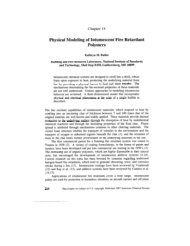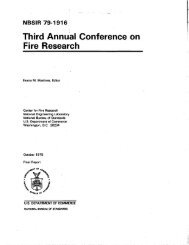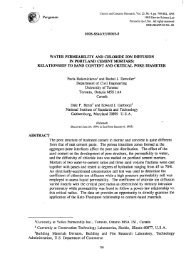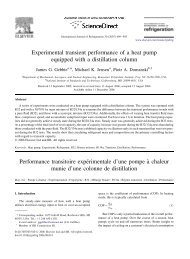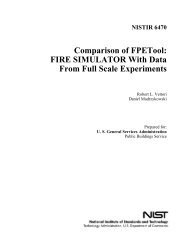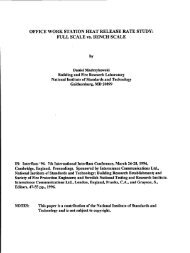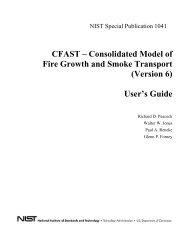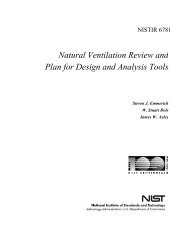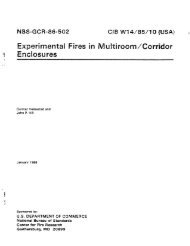Study of Technology for Detecting Pre-Ignition Conditions of ... - NIST
Study of Technology for Detecting Pre-Ignition Conditions of ... - NIST
Study of Technology for Detecting Pre-Ignition Conditions of ... - NIST
Create successful ePaper yourself
Turn your PDF publications into a flip-book with our unique Google optimized e-Paper software.
CI%C-IAG-95-1145<br />
tirou@out this section. The results and discussion focus pfimatily on comparing the same<br />
memurement from each different fire on the same plot and judging the potential use <strong>of</strong> that<br />
memurement as a universal pre-ignition signature. Not all <strong>of</strong> the measurements are compared,<br />
but certain measurements within each family <strong>of</strong> similar measurements were selected as both<br />
typical <strong>of</strong> the type <strong>of</strong> memurement and most practical <strong>for</strong> future implemen~tion based on<br />
location. The comparison plot curves all begin at the time the burner was energized and end<br />
about two seconds be<strong>for</strong>e the i~ition time. The oil and bacon in the electric-range tests ignited<br />
significantly faster than the same foods in the hi~-output gas-range tests. For this reason, the<br />
me~urement comparisons are separated by range type. “On” and “OW in the comparison plots<br />
legends refer to the status <strong>of</strong> the range hood <strong>for</strong> each test.<br />
3.2 ~e~~erat~res<br />
3.2.1 Pan arid Food<br />
Figure 5 shows the temperatures from the pan and food thermocouples as a function <strong>of</strong><br />
time <strong>for</strong> a test <strong>of</strong> oil heated on an electric range with the range hood <strong>of</strong>f. There was apparently<br />
no temperature gradient within the oil since the two food curves coincide. The pan inside-wall<br />
temperature was also identical to the food tempera~rm until ignition when the thermocouples in<br />
the oil were displaced from the pan by the lid as it was used to extinguish the fire. After<br />
ignition, the food tempera~es no longer indicated the temperature <strong>of</strong> the food since the<br />
themocmples lost contact with the food and were on top <strong>of</strong> the lid. After ignition, the panbottom<br />
temperature gradually approached the pan-side temperature.<br />
Figure 6 shows a comparison <strong>of</strong> the pan-bottom temperatures <strong>for</strong> all <strong>of</strong> the food and<br />
rmge-hood mmbinatiom heated on the electric range. The sugar results exhibit a much faster<br />
temperature rise because heat is tiasfemed to sugar less efficiently than to oil which allows the<br />
metal pan to retain more <strong>of</strong> its heat in the sugar case. The oil and bacon curves are all similar<br />
to each other. Figure 7 shows a comparison <strong>of</strong> the pan-bottom temperatures <strong>for</strong> all <strong>of</strong> the food<br />
and range ~mbinations heated on the hi@-output gas range. The tests <strong>of</strong> bacon and oil with the<br />
range hood <strong>of</strong>f experienced much higher temperatures than the same foods with the range hood<br />
on. It is utiom whether this was due to the lack <strong>of</strong> heat extraction by the hood or some other<br />
reason. It could also have been a conf@uration effect because a minor change in the proximity<br />
<strong>of</strong> the themowuple to the burner flame could greatly influence the measured temperatures.<br />
Figure 8 shows a comparison <strong>of</strong> the pan-side temperatures <strong>for</strong> all <strong>of</strong> the food and rangehood<br />
mmbinations heated on the electric range. Except <strong>for</strong> the test <strong>of</strong> oil with the range hood<br />
on, all <strong>of</strong> the temperature curves are similar. Figure 9 shows a comparison <strong>of</strong> the pan-side<br />
temperawes <strong>for</strong> all <strong>of</strong> the food and range ecnnbinations heated on the high-output gas range. The<br />
oil tests’ trends are similar, but the test with an inactive range hood does show faster heating.<br />
The sugar test results show a much faster temperature rise due to the initially dry state <strong>of</strong> the<br />
sugar, and the bacon test has a much slower temperature rise than either the sugar or oil.<br />
The temperatures <strong>of</strong> the food and pan may show reproducible and predictable pre-ignition<br />
behavior, but the locations are quite inconvenient <strong>for</strong> measurements during cooking. CM the<br />
electric range, the burner and pan bottom should experience similar conditions so the burner is<br />
20



